Sunday, September 9th, 2012 turned out what you might expect, weather-wise, from that date: sunny and 78 degrees. So far in 2012 not a drop of rain has fallen on a ForgottenTour, though admittedly two tours had to be postponed because of 95-degree temperatures. This was the best-attended of any tour thus far this year, with about 45 ForgottenFans — DUMBO has always been a ForgottenDraw, with nearly sixty people on the previous DUMBO tour, ForgottenTour #14, October 2002.
As usual I was accompanied by Rich Melnick, master tour guide at the Greater Astoria Historical Society.
In Disneyland, Dumbo means a flying elephant, but in Brooklyn, a new acronym was coined in the 1980s to refer to the mostly industrial area located beneath the Manhattan Bridge: “Down Under the Manhattan Bridge Overpass.” It’s rather awkward but gets the job done.
DUMBO developed into a major industrial area because of its convenient location and because of the availability of large plots of land. The East River has deep water that permits ships to tie up at docks directly adjacent to land. Thus raw materials could easily be shipped into the area’s factories and finished goods easily shipped out. In addition, the area was close to upland residential neighborhoods where factory owners and, more importantly, factory workers lived. In the final decades of the nineteenth century, transportation networks expanded in Brooklyn, adding to the convenience of manufacturing in DUMBO. New transportation such as the Fulton El (1880s-1940) made it easier for workers and factory owners to get to work from somewhat more distant neighborhoods. In recent years, the neighborhood has been redeveloped for mixed use, mainly residential.
We made about 30 stops in DUMBO, the Fulton Ferry area, and Vinegar Hill, the remnants of a small hamlet near the Navy Yard first settled in the 1790s…
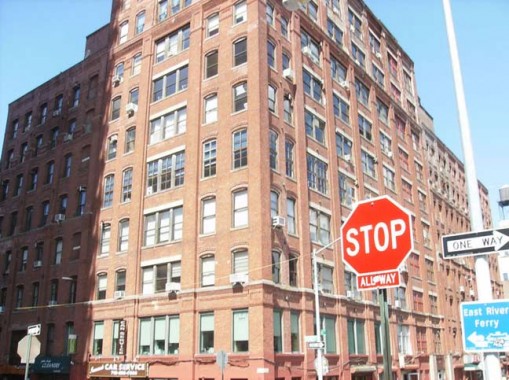
Grand Union Tea Company building, Jay and Front Streets.
Grand Union started as the Jones Brothers Tea Company in 1872. By the 1930s it was one of the largest grocery chains in the United States.
The 1904 edition of King’s Views of Brooklyn states that this was the “largest warehouse and factory in the United States for teas, coffees, spices, flavoring extracts, baking-powders and soaps.” Much of the firm’s output was manufactured at the large factory in DUMBO with its ten acres of floor space. They shipped 32,500,000 pounds of coffee from this plant each year, as well as 4,000,000 pounds of tea. Each day they shipped 120,000 cakes of soap and 20,000 pounds of baking soda.
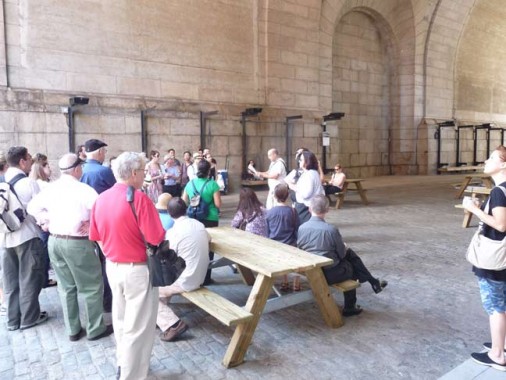
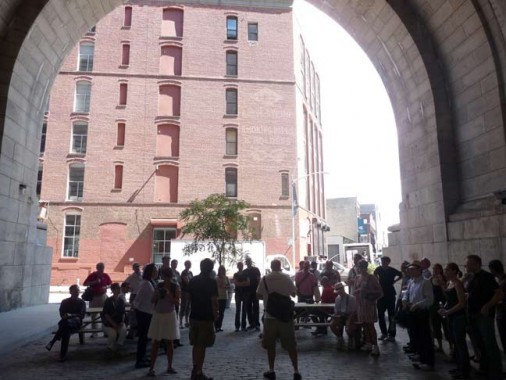
One of the benefits of DUMBO’s recent revival is the opening of new public spaces, not only along the waterfront, but also here, in the tunnel/arch that originally took Water Street under the Manhattan Bridge approach. This space had beeen for decades, used as a storage space for machinery and vehicles. Through the arch you can see 56 Pearl Street, built in 1891. Faintly seen is a painted ad for L. & H. Stern Smoking Pipes and Holders, which purchased the building in 1920.
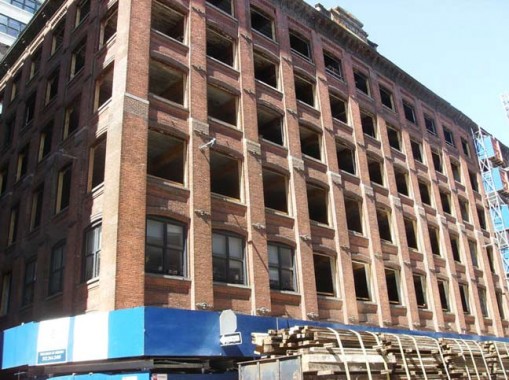
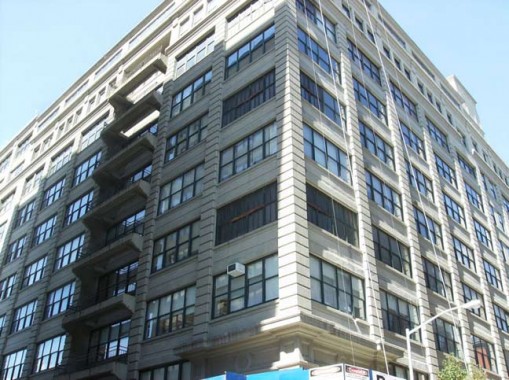
Both these buildings, which went up between 1890 and 1910, were built for the Robert Gair manufacturing empire.
Robert Gair became the dominant industrial presence in DUMBO in the early twentieth century. Gair was born in Edinburgh, Scotland in 1839 and came to America at the age of fourteen. He worked as a clerk in a dry goods store in New York City before serving in the Civil War (he reached the rank of captain). In 1864 he opened a business as a paper jobber in New York and then, in partnership with George West from 1867 until 1876, he began manufacturing paper bags with square bottoms. He also sold a wide variety of paper goods, many of which he also manufactured on machinery that he had constructed. However, it was Gair’s inventions relating to the manufacture of corrugated paper boxes that resulted in his firm’s growth. In 1870, Gair developed a machine for manufacturing corrugated paper and in 1879 patented a machine for creating folding boxes.
In 1888, as production grew, Gair moved his production from Tribeca to DUMBO. Gair’s choice of a site on the northwest corner of Washington Street Water Street was influenced by the recent move of his friend, coffee roaster John Arbuckle, to neighboring blocks. Robert Gair increasingly invested in real estate and became a major developer of industrial buildings in DUMBO, some of which his firm occupied and others which were leased.
In the early 1900s American engineers perfected the technique of reinforcing concrete with iron rods. Gair began building a number of such buildings on Washington Street in 1904. Reinforced concrete buildings were fireproof and took less time to build. Also, reinforced concrete floors could support heavier loads of machinery and the walls could hold large windows that let in more light.
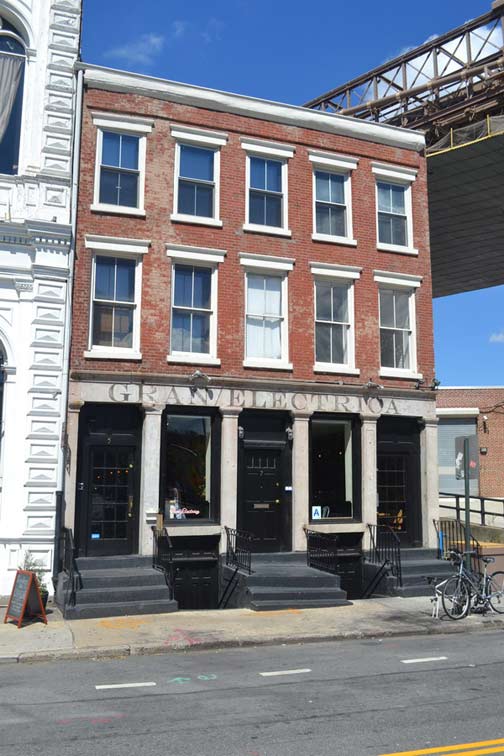
Long Island Insurance Company Building, Front Street near Old Fulton.
Built in 1834, it was originally an office building. Plans for the construction of the Brooklyn Bridge were discussed here.
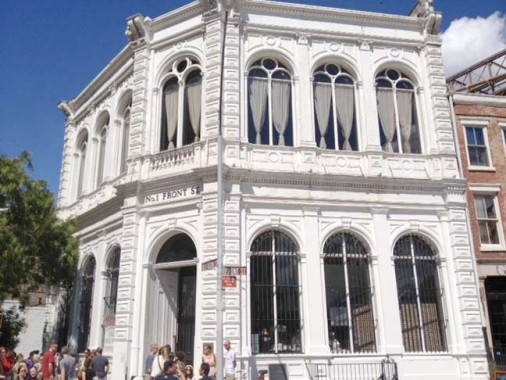
Long Island Safe Deposit Bank, #1 Front at Old Fulton.
One of Brooklyn’s more impressive cast-iron building facades is the Long Island Safe Deposit Company building, at #1 Front Street at Old Fulton, which dates to 1868 and was designed by William Mundell. The construction of the Brooklyn Bridge made life difficult for businesses on lower Fulton Street, and the bank was no exception; it closed in 1891. Its presence a testimony to how this part of town was formerly one of Brooklyn’s business hubs; its subsequent decline was symptomatic of the neighborhood’s decline after ferry service ended in 1924. In recent years, the building has been restored to much of its old glory. It recently became the home of longtime Old Fulton Street staple Grimaldi’s Pizza.
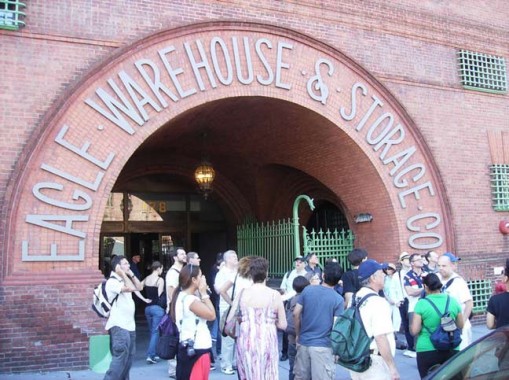
This handsome warehouse on Old Fulton Street across from Front, now converted to condominiums, comes packed with the history of one of Brooklyn’s literary lions, Walt Whitman. Best known for “Leaves of Grass”, the revolutionary collection of twelve poems that first appeared in 1855, as well as “Crossing Brooklyn Ferry” and “I Sing The Body Electric”, Whitman was born in West Hills, Long Island, in 1819. The young Walt worked as a typesetter and pressman in the 1830s for a couple of Brooklyn newspapers. After trying his hand at fiction in the 1830s, he took over as editor of the Brooklyn Eagle in 1846, a post he would keep until 1848, leaving in a dispute over abolition (Whitman was anti-slavery, Eagle owners weren’t. The Eagle continued to publish until 1955).
The Eagle Warehouse, 28 Old Fulton Street, was built by architect Frank Freeman in 1893 on the site of the old Brooklyn Eagle building. For 114 years the Eagle was Brooklyn’s hometown paper. While designing the new Eagle Warehouse, Freeman decided to leave intact the old three-story Brooklyn Eagle pressroom at Doughty Street and Elizabeth Place.

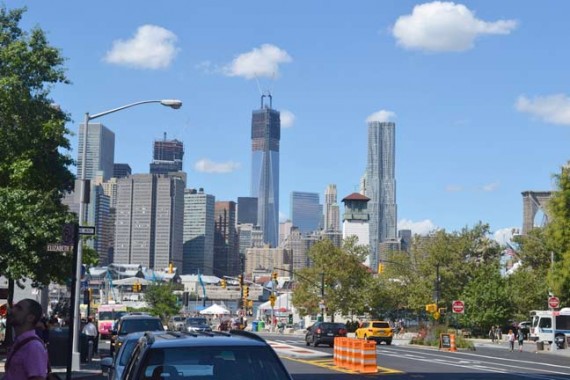
Old Fulton Street has always enjoyed spectacular views of not only Manhattan across the East River, but also of the Brooklyn Bridge. The outlook has changed drastically in the first decade of the 2000s with the construction of 1 World Trade Center and Frank Gehry’s 8 Spruce Street, the tallest residential tower in the USA.
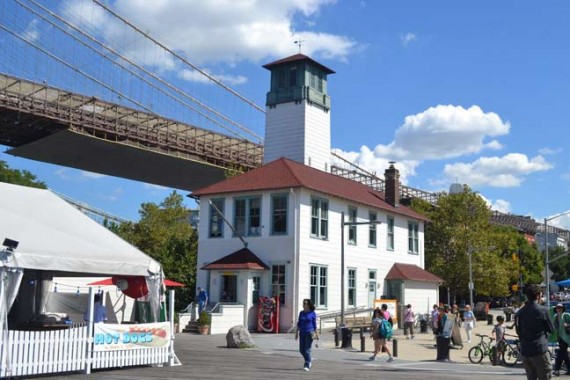
Now the Brooklyn Ice Cream Factory, this building, opened in 1926 at Old Fulton and Water Stret, was formerly used to berth fireboats and dry firehoses, hence the tall tower. The original Fulton Ferry ran to Manhattan from here for over 100 years, ending service in 1924; its elaborate and ornate ferry terminal building was then torn down, and this structure was built.
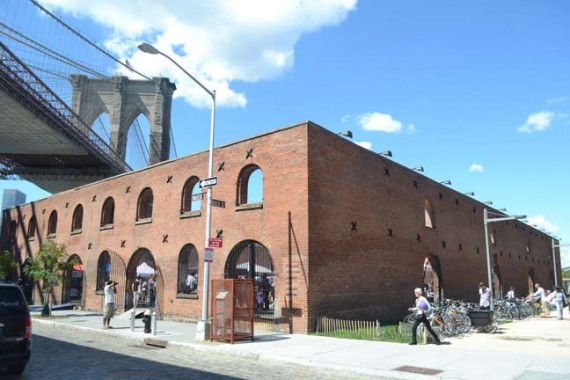
Tobacco Inspection Warehouse, Water and Dock Streets.
The Tobacco Warehouse, originally built by the Lorillard tobacco producing family around 1860, sits on the upland of Empire-Fulton Ferry Park, just north of the Brooklyn Bridge, and just south of the Empire Stores. Together, these landmark 19th century warehouses are vivid reminders of the shipping activity that once defined the downtown Brooklyn waterfront. Constructed in the 1870s as a tobacco customs inspection center, and saved from demolition in 1998. The building was used as a hideout in the 1990 Abel Ferrara film “King of New York.” It was originally 5 stories tall.
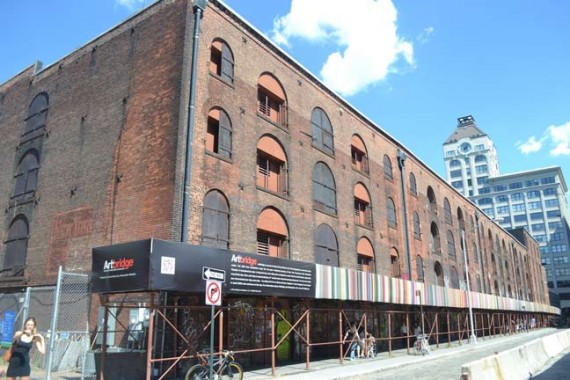
Empire Stores, Water Street between Dock and Main Streets.
Brothers John and Charles Arbuckle were the first national retailers of coffee and produced America’s first national coffee brand, Ariosa, which remains available, complete with a traditional piece of peppermint candy in the bag; the Arbuckles were also sugar importers, and early on, they kept their coffee from getting stale by glazing it in sugar. One of the Arbuckles’ leading creations was Yuban Coffee, introduced in 1913, a year after founder John Arbuckle’s death. Yuban (“Yuletide Banquet” – produced from special beans used by the Arbuckles during family holiday gatherings) had a vast advertisement on the exterior of 1870s-1880s-era warehouses along Water Street, known as the Empire Stores in the 1930s, memorialized in photographs by the famed Berenice Abbott.
Plans call for The Empire Stores to be turned into a mixed-use retail and commercial development that will help fund Brooklyn Bridge Park’s operations and maintenance.
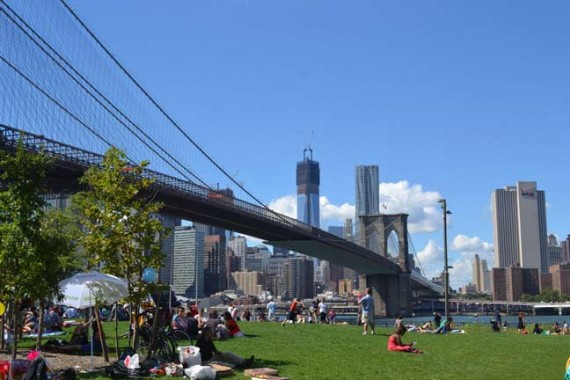
What started as a small patch of green at New Dock Street under the Brooklyn Bridge has spread east to Washington Street and west to Furman, and will eventually cover all of the waterfront as far south as Atlantic Avenue. This was formerly one of the world’s busiest ports, but business has moved to Newark and other locales, and the city has been converting it to parkland rather than have it sit idle.
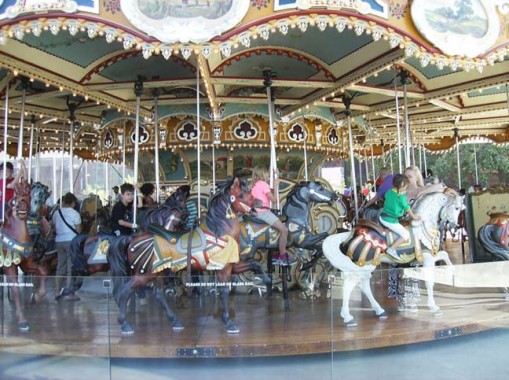
“Jane’s Carousel” in Brooklyn Bridge Park was created in 1922, the heyday of the American carousel, by the Philadelphia Toboggan Company (P.T.C.). Designated as P.T.C. No. 61, it was originally installed in Idora Park in Youngstown, Ohio, then a prosperous steel-making city. The Carousel has been fully restored back to its original elegance.
Jane and David Walentas (David Walentas has redeveloped acres of DUMBO for the past 40 years) purchased the Carousel at auction on October 21, 1984 and have worked to meticulously restore it. The highly decorative carved trappings were newly painted and re-leafed. Missing embellishments such as faceted jewels, small beveled mirrors on the bridles, and delicate pinstriping were restored.
Jay Street Connecting Railroad. What appear to be ancient trolley tracks are actually part of a small railroad that transported goods from the waterfront to various factories and manufacturing buildings in DUMBO.
The Jay Street Connecting Railroad operated as Brooklyn’s smallest waterfront railway between 1904 and 1959. The role of this small railroad was to move freight cars from carfloats on the East River to the industrial buildings and warehouses that would load and unload them. You can still see a few cases in which long-unused tracks are going into buildings. Thus, the JSCR filled about the same role as the old “High Line” on Manhattan’s West Side. The JSCR was built by the Arbuckle Brothers Coffee Company in the early 1900s to facilitate transport of goods among its various factory and warehouse buildings. Eventually, the Arbuckles made a profit by expanding the railroad further and having it serve other businesses in the area.
The little railroad thrived until the mid-1950s, even after the Arbuckles had sold off most of their waterside properties. After that, though, large containers that could be lifted by cranes from ships to trucks began to replace railroads as the prime means of freight transportation. Almost overnight, many freight railroads went out of business, and the JSCR was no different; it was abandoned in 1959, but in many cases, its trackage was never pulled up or paved over, and that’s what we see today.

E. W. Bliss Machine Works Building, Plymouth St between Adams and Pearl.
Between 1879 and c. 1900, Eliphalet W, Bliss erected three buildings for the manufacture of a vast array of machinery, cans, and other metal products. After service in the Civil War, Bliss settled in Brooklyn and in 1867 established a machine works which became the E. W. Bliss Company. In his DUMBO factories, Bliss manufactured machines, tools, presses, dies, and sheet metal. Bliss invented a machine for stamping out sheet-metal cans which were initially used for kerosene and paint. In 1884, Dr. L. P. Brockett, the author of “The Manufacturing Industries of Brooklyn and Kings County” section of Henry L. Stiles’s history of Brooklyn, wrote that Bliss “has built up in a few years an immense business in machinery for drawing and stamping cold plates of tin, sheet iron, brass or copper, in all the required forms for household and manufacturing use.”

54 Bridge Street – Hanan Building
The Hanan Company was among the first to stamp the firm’s name on every shoe, a daring idea at a time when most people still sought shoes handmade by the dealer. The firm was successful and in 1888 Hanan began opening retail stores to sell the factory’s product directly to consumers.
This factory was built in 1893. By 1913 the company employed 1,131 people in its Brooklyn factory. John Hanan also owned shoe companies in other cities and served as president of the National Boot and Shoe Manufacturers’ Association. Hanan went bankrupt in 1935 and the building was used by other manufacturers until its recent conversion to residential.

Hudson Avenue, Vinegar Hill.
Vinegar Hill is about a four or five block square neighborhood located east of DUMBO and north of the Farragut Houses. It’s a charming little area marked by brownstone buildings and Belgian-block streets that haven’t yet been asphalted. Other than a couple of groceries and bodegas on Gold and Bridge Streets, residents have to travel west to Brooklyn Heights, west to DUMBO, or south to the new MetroTech area for amenities. It’s all that is left of a rather more extensive residential area; it was gradually decimated by the construction of the nearby Brooklyn-Queens Expressway and the Farragut Houses south of York Street in the 40s and 50s.
The story of how Vinegar Hill got its name is an unusual one. Vinegar Hill has been here since 1800, when a John Jackson purchased its land from the Sands brothers (for whom Sands Street is named). Jackson actually hoped to attract Irish immigrants in an era when Irish were otherwise unwelcome. He named his tract Vinegar Hill after the site of a fierce battle in the unsuccessful Irish rebellion of 1798. In Ireland, the name “Vinegar Hill” was an English transliteration of an Irish Gaelic term meaning “hill of the wood of the berries.” Vinegar Hill has also been known as Irish Town. Most of its residences were built between the late 1820s and the 1850s; the latter ones reflect the Italianate style.
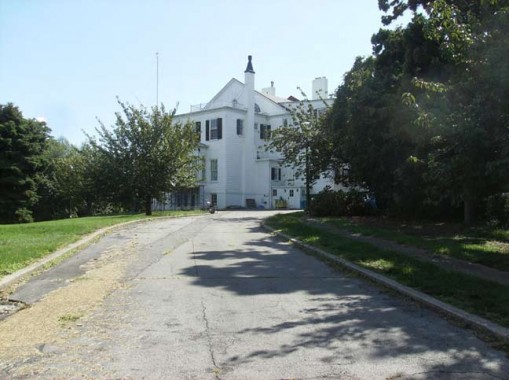
Commandant’s House, Brooklyn Navy Yard
Visible behind a gate at Evans and Little Streets, the Naval Commandant’s Hous is the crown jewel of the Brooklyn Navy Yard. It was built between 1806 and 1807 and is purportedly the design of Boston’s Charles Bulfinch. Bulfinch designed the U.S. Capitol Building as well as Faneuil Hall and the State House in Boston.
That just scratches the surface of the nearly 30 sites visited on what was a typically comprehensive Forgotten NY tour!
Photos: Bob Mulero, Tim Skoldberg, Joe DeMarco.
9/19/12

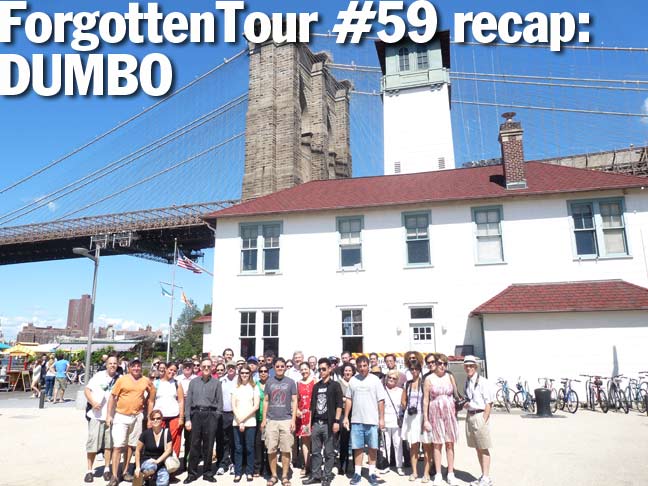


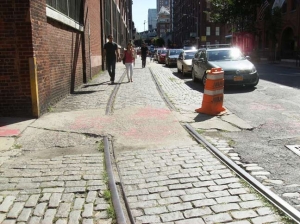
9 comments
Kevin, This was a fantastic tour. By the way, they all are good. Mark C
Last spring I did my own DUMBO walk and covered pretty much the same area you did. After Vinegar Hill and the Commandant’s house I followed the wall around the Navy Yard and took pix of the wreckage inside as well as some of the reuse that has been going on. When my ship was in the Navy Yard in 1985 DUMBO was confined in Disneyland and had not landed in Brooklyn yet. My walk to the A train stop at High Street went thru a wasteland of old buildings with nary a hipster in sight.
I always wondered what the Sweeney Mfg. Co. made.
I think they had the bldg. with a clock on all 4 sides.
Wait!I know.They made sweenies,right?
When Walentas re-developed the building at 1 Main St (the one with clock) in the 1980’s it earned the nickname ‘the clocktower building’. The building was one of Gair’s original buildings.
Since the redevelopment mortgage had been underwritten by the State and Walentas was having trouble finding tenants for his project, the NY Department of Labor leased 1 Main Street for their downstate offices about 1987 (after the leases ran out at 2 WTC). In order to get people to the area, Walentas ran a shuttle bus that made a stop on the Fulton Mall and then ran to Main Street. The old ‘Fishbowls’ that were used would rattle like crazy when they ran over cobble stone streets and the tracks left from the JSCR.
The Brooklyn Ice Cream Factory building also served for several years in the late 1970’s and early 80’s as the headquarters of the National Maritime Historical Society, a small group headed by Peter Stanford, who was also one of the founders of the South Street Seaport in the 60’s.
Ah-ha!
So they did make Sweenies after all!
I was right all along
[…] Forgotten Tour: Dumbo, 19Sept2012, ForgottenNY […]
I attended this tour. And I have say Rick and Kevin were very thorough in providing historical information about the area and the buildings……This was my frist time with Forgotten NY and I plan to attend the Green-wood Cemetery tour on Octboer 13.
My grandfather was one of three owners of an old paper box production company down by the old Brooklyn Nave Yard. I believe that the name of the company was BYN. I was wondering if there is any information pertaining to that company. He, an immigrant himself, along with two other immigrants from different countries, had established this company many years ago. His name was Irving Levine. If you happen to know where I can obtain information about that company, I would love to research it!